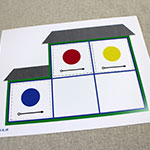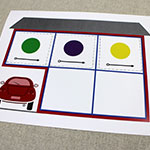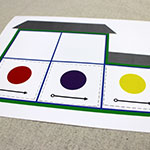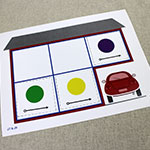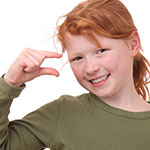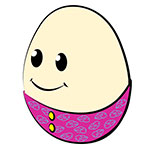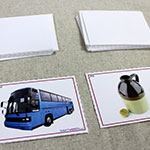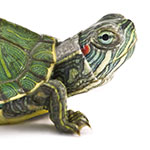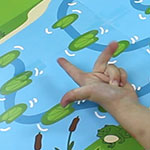Connecting Sounds
J1: Vowel Names
Use a popular children’s song to introduce your child to the names of the vowels. You will also teach your child the terms vowel and consonant.
J3: Word Surgery
Perform “surgery” on a word, cutting it up into its two sounds (phonemes), keeping them in the correct order.
J4: Snap It On: First Sound
“Snap” a sound onto the beginning of a word to make a completely new word.
J5: Snip It Off: First Sound
“Snip” a sound off the beginning of a word to make a completely new word.
J6: Snap It On: Last Sound
“Snap” a sound onto the end of a word to make a completely new word.
J7: Snip It Off: Last Sound
“Snip” a sound off the end of a word to make a completely new word.
J8: Snap or Snip: First Sound
Count the sounds in two spoken words and determine which one has more sounds.
J9: Snap or Snip: Last Sound
Count the sounds in two spoken words and determine which one has more sounds.
J10: Short Vowel Sounds
Introduce the short vowel sounds to your child, emphasizing that vowels are “smart letters” because they say their name and a sound.
J11: Bingo Vowel Song
Use a popular children’s song and a funny picture to help your child remember the short vowel sounds.
J12: Snatch a Match
Compare two short words, identify the vowel sound in each, and decide whether the two vowel sounds match.
J13: Turtle Talk
Synthesize three to five sounds into a whole word. This game introduces the skill of blending together individual sounds.
J14: Hop, Stop & Drop
Count and compare the sounds in two spoken words containing two to four sounds in order to “hop” across the lily pads to the other side of the pond.
J15: Sneak Preview of Reading
Introduce the use of letters in forming and reading three-sound words in the same word family.
1. Overview
In this module, your child will build upon the skills learned in Beginning Sounds, Ending Sounds, and Digraphs.
We start with an introduction to the vowel names (which are also the “long” vowel sounds). Later in the module, we will build on that knowledge by teaching the “short” vowel sounds.
Children will do several activities where they practice working with individual sounds (phonemes), adding and removing them from the beginning and end of short words. Children will also learn to count the number of sounds in these short words and to pay attention to the order of the sounds.
NOTE: This module is NOT about spelling words! We are identifying and counting sounds, not letters. Some words have a one-to-one correlation between their sounds and their letters (e.g., map), but some do not (for example, phone).
We wrap up this section with a Sneak Preview of Reading, which will give your child a taste of how the skills he/she has learned will soon lead to actual reading!
The ability to correctly identify, count, and order the sounds in words leads to formal learning of decoding and spelling later on (in Phonics). These activities build the foundation for success in later reading and spelling.
2. Connecting Sounds Activities
- J1: Vowel Names – Use a popular children’s song to introduce your child to the names of the vowels. You will also teach your child the terms vowel and consonant.
- J2: Connect the Sounds – Blend two sounds together, in order, to make a word.
- J3: Word Surgery – Perform “surgery” on a word, cutting it up into its two sounds (phonemes), keeping them in the correct order.
- J4: Snap It On: First Sound – “Snap” a sound onto the beginning of a word to make a completely new word.
- J5: Snip It Off: First Sound – “Snip” a sound off the beginning of a word to make a completely new word.
- J6: Snap It On: Last Sound – “Snap” a sound onto the end of a word to make a completely new word.
- J7: Snip It Off: Last Sound – “Snip” a sound off the end of a word to make a completely new word.
- J8: Snap or Snip: First Sound – Count the sounds in two spoken words and determine which one has more sounds.
- J9: Snap or Snip: Last Sound – Count the sounds in two spoken words and determine which one has more sounds.
- J10: Short Vowel Sounds – Introduce the short vowel sounds to your child, emphasizing that vowels are “smart letters” because they say their name and a sound.
- J11: Bingo Vowel Song – Use a popular children’s song and a funny picture to help your child remember the short vowel sounds.
- J12: Snatch a Match – Compare two short words, identify the vowel sound in each, and decide whether the two vowel sounds match.
- J13: Turtle Talk – Synthesize three to five sounds into a whole word. This game introduces the skill of blending together individual sounds.
- J14: Hop, Stop & Drop – Count and compare the sounds in two spoken words containing two to four sounds in order to “hop” across the lily pads to the other side of the pond.
- J15: Sneak Preview of Reading – Introduce the use of letters in forming and reading three-sound words in the same word family.
Leave a Reply





